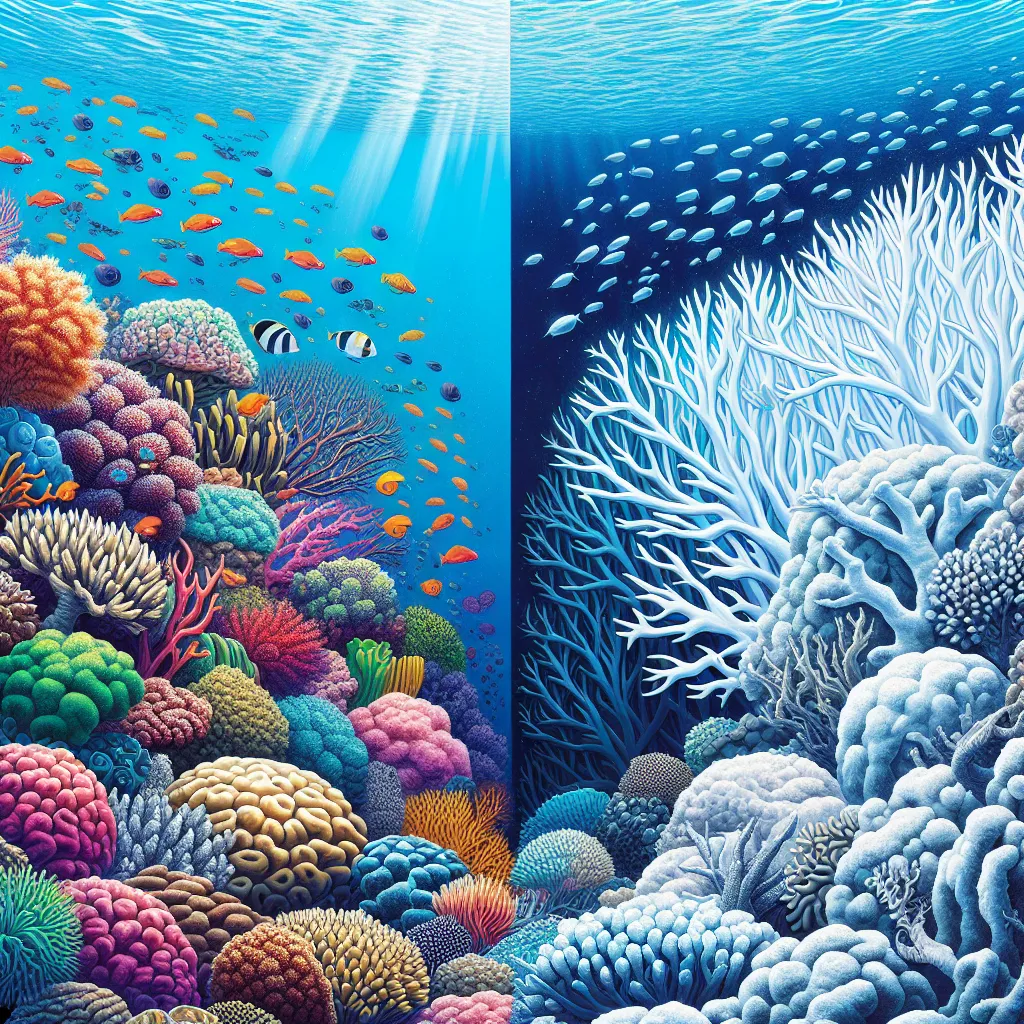The IELTS Reading section tests your ability to understand and analyze complex texts on various topics. One recurring theme in recent years has been the impact of climate change on our environment, particularly on coral reefs. This topic has appeared in several past IELTS exams and, given its growing relevance, is likely to feature in future tests as well. Today, we’ll explore a practice passage on “Climate change’s impact on coral reefs” to help you prepare for the IELTS Reading test.
Practice Passage: Climate Change and Coral Reefs
Reading Passage
Climate change is having a profound impact on coral reefs worldwide, threatening these diverse and vital ecosystems. Coral reefs, often called the “rainforests of the sea,” are home to a quarter of all marine species and provide crucial services to human communities. However, rising sea temperatures, ocean acidification, and extreme weather events linked to climate change are pushing many coral reefs to the brink of collapse.
One of the most visible effects of climate change on coral reefs is coral bleaching. This phenomenon occurs when water temperatures rise above corals’ tolerance levels, causing them to expel the colorful algae living in their tissues. Without these algae, which provide corals with essential nutrients and their vibrant colors, corals turn white and become more susceptible to disease and death. The frequency and severity of mass bleaching events have increased dramatically in recent decades, with the Great Barrier Reef experiencing three major bleaching events in just five years between 2016 and 2020.
Ocean acidification, another consequence of climate change, poses a significant threat to coral reefs. As the ocean absorbs more carbon dioxide from the atmosphere, it becomes more acidic. This increased acidity makes it harder for corals and other marine organisms to build their calcium carbonate skeletons, weakening the entire reef structure. Scientists predict that if current trends continue, many coral reefs may stop growing entirely by the end of this century.
The impacts of climate change on coral reefs extend far beyond the marine environment. Millions of people depend on coral reefs for food, income, and coastal protection. The loss of coral reefs could lead to decreased fish populations, reduced tourism revenue, and increased coastal erosion. In some low-lying island nations, the degradation of protective reef barriers could make entire communities more vulnerable to storms and rising sea levels.
Despite these challenges, there is hope for coral reefs. Some coral species are showing signs of adaptation to warmer waters, and scientists are working on innovative solutions to protect and restore reefs. These efforts include developing heat-resistant coral strains, implementing marine protected areas, and reducing local stressors like overfishing and pollution. However, the most crucial step in saving coral reefs is addressing the root cause of their decline: climate change itself. Reducing greenhouse gas emissions and limiting global temperature rise is essential for the long-term survival of these irreplaceable ecosystems.
 Coral reef bleaching due to climate change
Coral reef bleaching due to climate change
Questions
1-5. Do the following statements agree with the information given in the reading passage?
Write:
TRUE if the statement agrees with the information
FALSE if the statement contradicts the information
NOT GIVEN if there is no information on this
- Coral reefs are home to half of all marine species.
- The Great Barrier Reef experienced three major bleaching events between 2016 and 2020.
- Ocean acidification makes it easier for corals to build their calcium carbonate skeletons.
- The loss of coral reefs could lead to increased coastal erosion.
- All coral species are equally vulnerable to the effects of climate change.
6-10. Complete the summary below using NO MORE THAN TWO WORDS from the passage for each answer.
Climate change is having severe impacts on coral reefs worldwide. One of the most visible effects is coral (6) ____, which occurs when water temperatures rise, causing corals to expel colorful algae. This makes corals more susceptible to (7) ____ and death. Another threat is ocean (8) ____, which makes it harder for corals to build their skeletons. The loss of coral reefs affects not only marine life but also human communities, potentially leading to decreased (9) ____ populations and reduced tourism revenue. Despite these challenges, some coral species are showing signs of (10) ____ to warmer waters, and scientists are working on innovative solutions to protect and restore reefs.
Answers and Explanations
-
FALSE
Explanation: The passage states that coral reefs are “home to a quarter of all marine species,” not half. -
TRUE
Explanation: The passage explicitly mentions that “the Great Barrier Reef experiencing three major bleaching events in just five years between 2016 and 2020.” -
FALSE
Explanation: The passage states that increased acidity “makes it harder for corals and other marine organisms to build their calcium carbonate skeletons,” not easier. -
TRUE
Explanation: The passage mentions that “The loss of coral reefs could lead to decreased fish populations, reduced tourism revenue, and increased coastal erosion.” -
NOT GIVEN
Explanation: While the passage discusses the vulnerability of coral reefs to climate change, it does not provide information about whether all coral species are equally vulnerable. -
bleaching
-
disease
-
acidification
-
fish
-
adaptation
Common Mistakes
When tackling this type of passage in the IELTS Reading test, students often make the following mistakes:
- Misinterpreting “Not Given” answers: Remember, if the information is not explicitly stated in the passage, choose “Not Given.”
- Overlooking synonyms: The test often uses synonyms or paraphrases of words in the passage. Be prepared to recognize these.
- Rushing through the passage: Take time to understand the overall structure and main ideas before attempting the questions.
- Relying too heavily on prior knowledge: Base your answers solely on the information provided in the passage.
Key Vocabulary
- Coral bleaching: [ˈkɒrəl ˈbliːtʃɪŋ] (noun) – The process where corals lose their vibrant colors due to stress, often caused by increased water temperatures.
- Ocean acidification: [ˈəʊʃən əˌsɪdɪfɪˈkeɪʃn] (noun) – The ongoing decrease in the pH of the Earth’s oceans, caused by the uptake of carbon dioxide from the atmosphere.
- Ecosystem: [ˈiːkəʊˌsɪstəm] (noun) – A biological community of interacting organisms and their physical environment.
- Biodiversity: [ˌbaɪəʊdaɪˈvɜːsɪti] (noun) – The variety of plant and animal life in a particular habitat or on Earth as a whole.
- Adaptation: [ædəpˈteɪʃn] (noun) – The process of change by which an organism or species becomes better suited to its environment.
Grammar Focus
Pay attention to the use of conditional sentences in the passage, such as:
“Scientists predict that if current trends continue, many coral reefs may stop growing entirely by the end of this century.”
This is an example of a first conditional sentence, used to talk about a possible future outcome based on a specific condition. The structure is:
If + present simple, will/may/might + infinitive
Practice using this structure to discuss other potential environmental impacts or solutions.
Tips for Success
- Read the passage quickly first to get a general understanding before looking at the questions.
- Use the headings and any visual aids to help you navigate the text more efficiently.
- Pay attention to transition words and phrases that indicate relationships between ideas.
- Practice time management – allocate your time wisely between reading and answering questions.
- Improve your vocabulary related to environmental topics, as these are common in IELTS tests.
Remember, success in the IELTS Reading test comes with practice and familiarity with various question types. Keep practicing with diverse passages on different topics to improve your skills and confidence. Good luck with your IELTS preparation!


